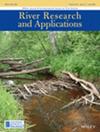Patterns of riparian forest disturbance caused by tree dislodging on a subtropical river during large floods
IF 1.9
4区 环境科学与生态学
Q4 ENVIRONMENTAL SCIENCES
引用次数: 0
Abstract
Riparian forests contribute to the resilience and biocomplexity of floodplains but may be catastrophically impacted by large floods. Forest disturbances will expose floodplains to stripping and pulses of large wood recruitment to the floodplain and channel. The widespread uprooting of trees follows hydrodynamic loading from floodwaters and the associated moments of these forces about the tree bases. A tree will uproot when the drag moment exceeds the anchorage resistance capacity. Alternatively, trunks will rupture when the tensile stresses caused by bending exceed the tensile strength of the outer trunk fibres. The likelihood and pattern of trees dislodging during floods on a subtropical river was investigated by developing a tree stability model. The modeling framework included development of a drag moment model and testing several potential formulations for anchorage resistance. Model parameters were calibrated to data collected in experiments and from observations in aerial photographs before and after a large flood in 2011. The prediction accuracy for the adopted tree stability model was 78%. Results from design flood simulations suggest that less than a third of the forest will dislodge even during the largest floods conceivable. This remarkable stability moderates the quantity of large wood recruited from riparian forests during extreme floods, which can impact infrastructure such as bridges and culverts downstream. Low rates of wood recruitment from dislodged floodplain trees in extreme floods suggests bank erosion is the dominant source of wood recruitment in these catchments.大洪水期间亚热带河流上树木移位对河岸森林造成的干扰模式
河岸森林有助于洪泛平原的恢复能力和生物复杂性,但可能会受到大洪水的灾难性影响。森林扰动会使洪泛平原遭受剥蚀,并使洪泛平原和河道中的大型木材大量涌入。洪水产生的水动力负荷以及这些力对树木基部产生的相关力矩会导致树木大面积连根拔起。当阻力矩超过锚固抗力时,树木就会连根拔起。或者,当弯曲造成的拉伸应力超过树干外层纤维的抗拉强度时,树干就会断裂。通过建立树木稳定性模型,对亚热带河流洪水期间树木移位的可能性和模式进行了研究。建模框架包括开发阻力矩模型和测试几种潜在的锚固阻力公式。模型参数根据实验收集的数据和 2011 年大洪水前后的航拍观测数据进行了校准。所采用的树木稳定性模型的预测准确率为 78%。设计洪水模拟结果表明,即使在可以想象的最大洪水中,也只有不到三分之一的森林会移位。这种出色的稳定性缓和了在特大洪水期间从河岸森林中移入的大木头数量,这可能会对下游的桥梁和涵洞等基础设施造成影响。在特大洪水中,从移位的河漫滩树木中吸收木材的比率很低,这表明河岸侵蚀是这些流域吸收木材的主要来源。
本文章由计算机程序翻译,如有差异,请以英文原文为准。
求助全文
约1分钟内获得全文
求助全文
来源期刊

River Research and Applications
环境科学-环境科学
CiteScore
4.60
自引率
9.10%
发文量
158
审稿时长
6 months
期刊介绍:
River Research and Applications , previously published as Regulated Rivers: Research and Management (1987-2001), is an international journal dedicated to the promotion of basic and applied scientific research on rivers. The journal publishes original scientific and technical papers on biological, ecological, geomorphological, hydrological, engineering and geographical aspects related to rivers in both the developed and developing world. Papers showing how basic studies and new science can be of use in applied problems associated with river management, regulation and restoration are encouraged as is interdisciplinary research concerned directly or indirectly with river management problems.
 求助内容:
求助内容: 应助结果提醒方式:
应助结果提醒方式:


